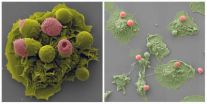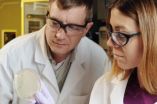(Press-News.org) BLOOMINGTON, Ind. -- An Indiana University study has found that three easy -- one could even say slow -- 5-minute walks can reverse harm caused to leg arteries during three hours of prolonged sitting.
Sitting for long periods of time, like many people do daily at their jobs, is associated with risk factors such as higher cholesterol levels and greater waist circumference that can lead to cardiovascular and metabolic disease. When people sit, slack muscles do not contract to effectively pump blood to the heart. Blood can pool in the legs and affect the endothelial function of arteries, or the ability of blood vessels to expand from increased blood flow.
This study is the first experimental evidence of these effects, said Saurabh Thosar, a postdoctoral researcher at Oregon Health & Science University, who led the study as a doctoral candidate at IU's School of Public Health-Bloomington.
"There is plenty of epidemiological evidence linking sitting time to various chronic diseases and linking breaking sitting time to beneficial cardiovascular effects, but there is very little experimental evidence," Thosar said. "We have shown that prolonged sitting impairs endothelial function, which is an early marker of cardiovascular disease, and that breaking sitting time prevents the decline in that function."
The researchers were able to demonstrate that during a three-hour period, the flow-mediated dilation, or the expansion of the arteries as a result of increased blood flow, of the main artery in the legs was impaired by as much as 50 percent after just one hour. The study participants who walked for 5 minutes each hour of sitting saw their arterial function stay the same -- it did not drop throughout the three-hour period. Thosar says it is likely that the increase in muscle activity and blood flow accounts for this.
"American adults sit for approximately eight hours a day," he said. "The impairment in endothelial function is significant after just one hour of sitting. It is interesting to see that light physical activity can help in preventing this impairment."
The study involved 11 non-obese, healthy men between the ages of 20-35 who participated in two randomized trials. In one trial they sat for three hours without moving their legs. Researchers used a blood pressure cuff and ultrasound technology to measure the functionality of the femoral artery at baseline and again at the one-, two- and three-hour mark.
In the second trial, the men sat during a three-hour period but also walked on a treadmill for 5 minutes at a speed of 2 mph at the 30-minute mark, 1.5-hour mark and 2.5-hour mark. Researchers measured the functionality of the femoral artery at the same intervals as in the other trial.
INFORMATION:
The study "Effect of Prolonged Sitting and Breaks in Sitting Time on Endothelial Function" will be published in Medicine & Science in Sports & Exercise, the official journal of the American College of Sports Medicine, and is appearing online early.
For a copy of the paper or to speak with Thosar, contact him at thosar@ohsu.edu or Tracy James at 812-855-4507 or traljame@iu.edu.
The study was supported by the American College of Sports Medicine Foundation Doctoral Research Grant and by Indiana University. Co-authors include Sylvanna L. Bielko, Jeanne D. Johnston and Janet P. Wallace, all from the Department of Kinesiology in the IU School of Public Health-Bloomington; and Kieren J. Mather, IU School of Medicine. The study was conducted at the Clinical Exercise Physiology lab headed by Janet P. Wallace.
Taking short walking breaks found to reverse negative effects of prolonged sitting
2014-09-08
ELSE PRESS RELEASES FROM THIS DATE:
Sleeping on animal fur in infancy found to reduce risk of asthma
2014-09-08
Munich, Germany: Sleeping on animal fur in the first three months of life might reduce the risk of asthma in later childhood a new study has found.
The new research, presented at the European Respiratory Society (ERS) International Congress in Munich today (8 September 2014), suggests that exposure to the microbial environment in animal skin and fur could have a protective effect against asthma and allergies.
Previous studies have suggested that exposure to a wider range of environments fromyoung age could be protective against asthma and allergies. These findings ...
The Lancet HIV: High rates of recreational drug use among HIV-positive gay and bisexual men in the UK strongly linked with condomless sex
2014-09-08
New research published in The Lancet HIV shows that polydrug use is common among HIV-positive men who have sex with men (MSM) [1] and is strongly linked to sex without a condom (condomless sex).
This is the largest questionnaire study of people living with HIV in the UK, accounting for about 5% of all HIV-diagnosed MSM in the UK. The findings show that half of MSM surveyed had used recreational drugs at least once in the previous 3 months [2]. About half of those who used drugs took three or more different types of drugs, while roughly a fifth said they had used five ...
The Lancet Respiratory Medicine: Benralizumab for chronic obstructive pulmonary disease and sputum eosinophilia
2014-09-08
Chronic obstructive pulmonary disease (COPD) is associated with eosinophilic airway inflammation in 10–20% of patients. Benralizumab, a monoclonal antibody, has been shown to decrease the number of blood and sputum eosinophils. In this trial of 101 patients with COPD whether benralizumab reduces the number of acute exacerbations was investigated. Benralizumab was found to be no more effective at preventing acute COPD exacerbations than placebo overall. However, the authors conclude that subgroup analyses suggest more research into the use of benralizumab in patients with ...
Dynamic duo takes out the cellular trash
2014-09-07
LA JOLLA—In most of the tissues of the body, specialized immune cells are entrusted with the task of engulfing the billions of dead cells that are generated every day. When these garbage disposals don't do their job, dead cells and their waste products rapidly pile up, destroying healthy tissue and leading to autoimmune diseases such as lupus and rheumatoid arthritis.
Now, Salk scientists have discovered how two critical receptors on these garbage-eating cells identify and engulf dead cells in very different environments, as detailed today in Nature Immunology.
"To ...
Platelet-like particles augment natural blood clotting for treating trauma
2014-09-07
A new class of synthetic platelet-like particles could augment natural blood clotting for the emergency treatment of traumatic injuries – and potentially offer doctors a new option for curbing surgical bleeding and addressing certain blood clotting disorders without the need for transfusions of natural platelets.
The clotting particles, which are based on soft and deformable hydrogel materials, are triggered by the same factor that initiates the body's own clotting processes. Testing done in animal models and in a simulated circulatory system suggest that the particles ...
Why age reduces our stem cells' ability to repair muscle
2014-09-07
Ottawa, Canada (September 7, 2014) — As we age, stem cells throughout our bodies gradually lose their capacity to repair damage, even from normal wear and tear. Researchers from the Ottawa Hospital Research Institute and University of Ottawa have discovered the reason why this decline occurs in our skeletal muscle. Their findings were published online today in the influential journal Nature Medicine.
A team led by Dr. Michael Rudnicki, senior scientist at the Ottawa Hospital Research Institute and professor of medicine at the University of Ottawa, found that as muscle ...
Rethinking the basic science of graphene synthesis
2014-09-07
A new route to making graphene has been discovered that could make the 21st century's wonder material easier to ramp up to industrial scale. Graphene -- a tightly bound single layer of carbon atoms with super strength and the ability to conduct heat and electricity better than any other known material -- has potential industrial uses that include flexible electronic displays, high-speed computing, stronger wind-turbine blades, and more-efficient solar cells, to name just a few under development.
In the decade since Nobel laureates Konstantin Novoselov and Andre Geim proved ...
Targeting the protein-making machinery to stop harmful bacteria
2014-09-07
One challenge in killing off harmful bacteria is that many of them develop a resistance to antibiotics. Researchers at the University of Rochester are targeting the formation of the protein-making machinery in those cells as a possible alternate way to stop the bacteria. And Professor of Biology Gloria Culver has, for the first time, isolated the middle-steps in the process that creates that machinery—called the ribosomes.
"No one had a clear understanding of what happened inside an intact bacterial cell," said Culver, "And without that understanding, it would not be ...
Continuing Bragg legacy of structure determination
2014-09-07
Over 100 years since the Nobel Prize-winning father and son team Sir William and Sir Lawrence Bragg pioneered the use of X-rays to determine crystal structure, University of Adelaide researchers have made significant new advances in the field.
Published in the journal Nature Chemistry today, Associate Professors Christian Doonan and Christopher Sumby and their team in the School of Chemistry and Physics, have developed a new material for examining structures using X-rays without first having to crystallise the substance.
"2014 is the International Year of Crystallography, ...
Ultraviolet light-induced mutation drives many skin cancers, Stanford researchers find
2014-09-07
A genetic mutation caused by ultraviolet light is likely the driving force behind millions of human skin cancers, according to researchers at the Stanford University School of Medicine.
The mutation occurs in a gene called KNSTRN, which is involved in helping cells divide their DNA equally during cell division.
Genes that cause cancer when mutated are known as oncogenes. Although KNSTRN hasn't been previously implicated as a cause of human cancers, the research suggests it may be one of the most commonly mutated oncogenes in the world.
"This previously unknown oncogene ...


